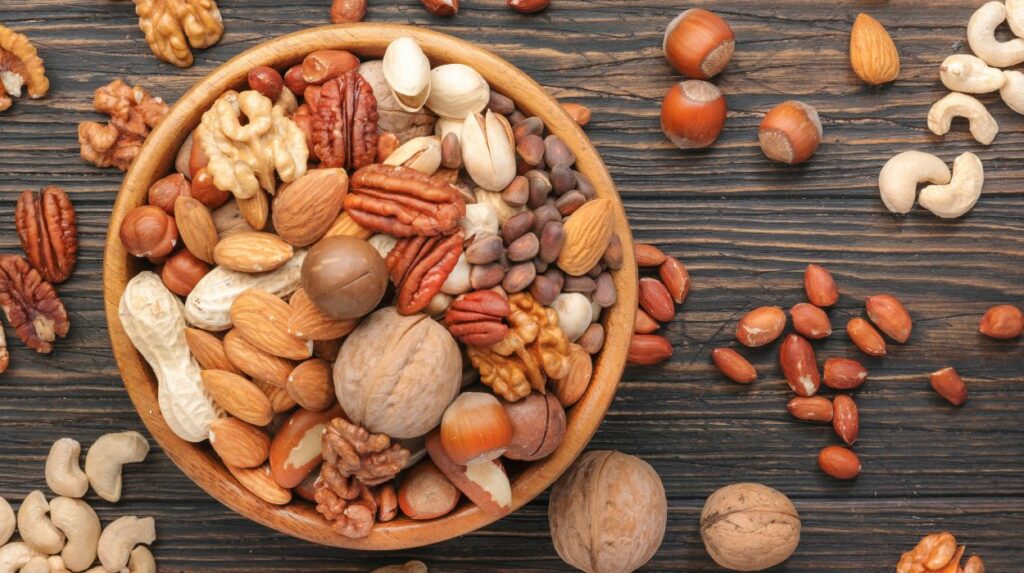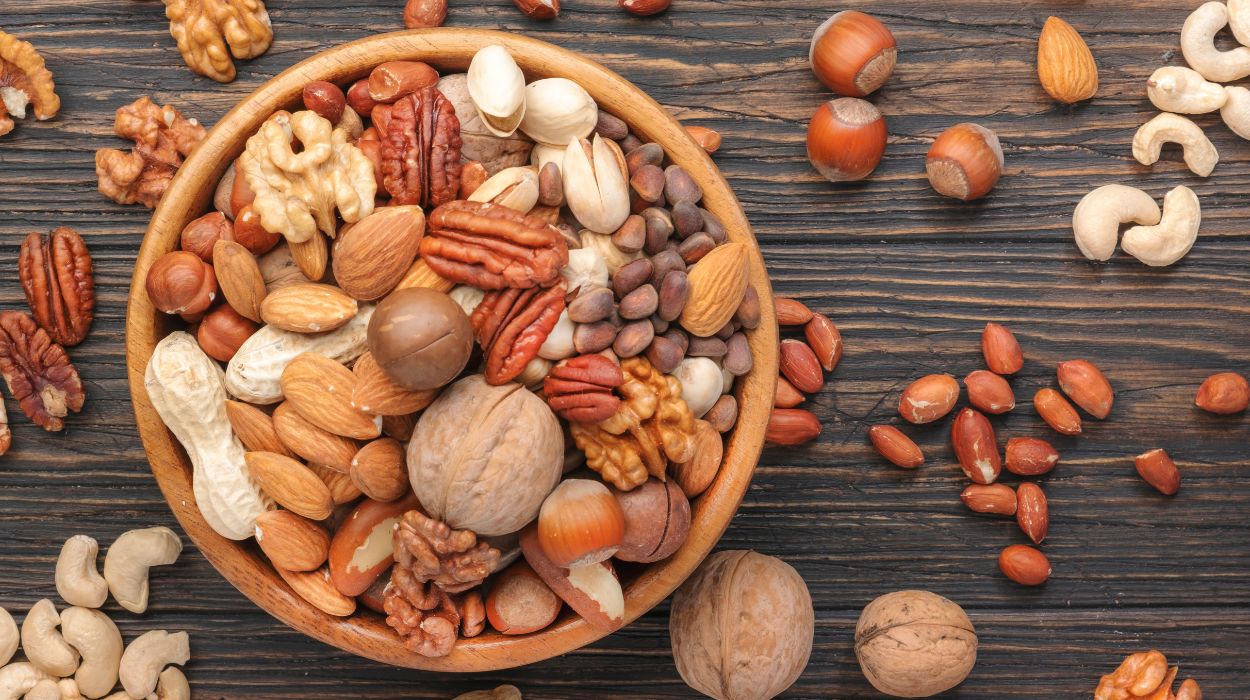10 Superfoods for Kids & Toddlers to Boost Physical & Mental Health 2024

It’s back to school time, and you know what that means, the daily task of trying to make healthy school lunches that your kids will eat. Nothing is more frustrating than getting 75% of your packed lunch returned to you at the end of the day.
There is not a list of rules that makes a food a superfood. Instead, the term superfoods are in response to a food item that is high in nutrients and positively affects your health.
Here is a list of healthy superfoods for kids that help with brain development, disease prevention, and proper growth.
10 Healthy Superfoods for Kids & Toddlers
- Eggs
- Berries
- Nuts and seeds
- Avocado
- Olive oil
- Dark leafy greens
- Oatmeal
- Legumes
- Tomatoes
- Carrots
10 Healthy Superfoods for Kids & Toddlers
Here are the top 10 kids’ superfoods that can help them grow healthfully and happily as well as hopefully influence a lifetime of good eating habits.
Eggs

Eggs are coined the perfect food for a good reason. Just one egg provides[1] loads of protein, vitamins, minerals, and healthy omega-3 fatty acids.
Eggs are also high in a lesser-known nutrient called choline[2]. The primary function of choline is to build cell membranes and signal molecules in the brain. Very few food products naturally contain choline; eggs are essential because they can provide this rare nutrient.
Starting your child’s day with a healthy dose of lean protein from eggs can help hold your child’s hunger over until lunchtime.
Studies[3] have proven that increasing the protein in your diet makes a person less hungry. Therefore, consuming eggs at breakfast can also aid as a healthy weight maintenance tool. Hard-boiled eggs can also be a terrific afternoon snack once children get home from school.
Eggs have long gotten a bad wrap due to their high cholesterol content. However, recent research[4] has proven the cholesterol in eggs is not responsible for increasing blood cholesterol. What does raise blood cholesterol is fatty foods and processed sugars.
Berries
Whether you choose raspberries, blueberries, strawberries, or blackberries, it doesn’t matter. They are all considered superfoods. This is because they are loaded[5] with vitamins, minerals, fiber, and many antioxidants.
Antioxidants[6] are super important to your health as they protect your body against cell-damaging free radicals. Free Radicals[7] are like the villain of your body and a major factor in aging.
They are unstable molecules that, if they become too abundant in the body, create all types of diseases such as heart disease, diabetes, and even cancer.
Antioxidants are the heroes. They fight off free radicals and neutralize their effects. Berries are easily added to foods by sprinkling on oatmeal, placed on top of ice cream, or mixed into yogurt.
Nuts and Seeds

Nuts and seeds are a great snack in a school lunch that contains large amounts of healthy fat and protein, to hold your little ones over until lunch or dinner time.
The healthy fats in nuts and seeds are unsaturated[8], meaning they will not build up cholesterol as plaque on artery walls to cause a heart attack or stroke.
Instead, these fats help disperse and dispense of those nasty fats that build up on artery walls. They do this by grabbing and taking them to the liver to break them down for excretion from the body.
Nuts are also high in antioxidants which we previously discussed. They fight off free radicals and keep your cells healthy.
One study[9] demonstrated that some nuts (walnuts) fight off free radicals better than fatty fish such as wild salmon. Apples with almond butter are a great kid-friendly snack filled with essential fats.
Different ways to include nuts and seeds in your child’s diet are
- Apples with almond butter (nut butters are filled with essential fats)
- Sunflower seeds, pine nuts, pumpkin seeds, raisins, and chocolate chips as a trail mix
- Mix seeds or finely chopped nuts into yogurt
Avocado
As your kids return to school, the number one thing parents usually worry about is cold and flu season, which seems to run rampant once the kids start school.
Avocados[10] contain many nutrients[11] that benefit your immune system, such as
- Vitamin B2
- Niacin
- Folate
- Copper
- Potassium
- Vitamin E
Your immune system needs potassium. It is necessary for almost every function within your cells and tissues.
Unfortunately, most of the population does not receive enough potassium[12] in their diet. Avocados contain high levels of potassium, actually more than bananas.
Olive Oil
Olive oil is also loaded with unsaturated fats that keep your heart happy. They are also filled[13] with antioxidants such as vitamins E and K, which protect against cellular damage from oxidative stress.
The more expensive extra virgin olive oil[14] (EVOO), made by cold-pressing instead of by heat or chemical solvents, is the best source of these.
You should swap out olive oil for any manufactured oils, such as vegetable oil, as these oils may be harmful to the body by causing chronic inflammation. Chronic inflammation is becoming an increasing problem in our young people.
Some symptoms[15] of chronic inflammation in kids include
- Fatigue
- Muscle aches
- Depression and mood swings
- Anemia
- Feeling chronically ill
Another way to help your child with chronic inflammation is to cut out processed foods and added sugars from their diet. Seek out foods that are a source of omega-3 fatty acids, instead of the ones with saturated and/or trans-fats, as with vegetable oil.
Dark Leafy Greens
Speaking of how to reduce inflammation, dark leafy greens are a fantastic anti-inflammatory. This is because they contain antioxidants called carotenoids.
Besides decreasing inflammation, dark leafy greens also provide tons of additional nutrition[16], such as
- Folate
- Zinc
- Calcium
- Iron
- Magnesium
- Vitamin C
- Fiber
All these nutrients that dark leafy greens provide reduce a person’s risk of chronic diseases such as heart disease, diabetes, and cancers. The real question is how to get your kids to eat dark leafy greens.
Here are a few tried and true ways to make dark leafy greens kid-friendly:
- Blend them into a smoothie with lots of berries
- Choose baby kale (less bitter)
- Add dark leafy greens to your soups
- Add nuts, olive oil, and lemon juice to greens for additional flavor
- Cook greens over medium heat with coconut oil, salt, garlic and pepper(sometimes cooking greens can add a different flavor)
Oatmeal
A bowl of cereal is so easy to put together for breakfast during a rushed morning. However, most cereals are loaded with sugar and hardly any fiber. This means children’s blood sugar levels will rise and crash soon after arriving at school.
Instead, fill their bowls with oatmeal. Oats[17] are full of fiber, which will slow the digestion of sugar in their bodies (slower absorption means less absorption), so your kids will have an improved mood and no sugar crash.
Legumes
Legumes, including peas, beans, and lentils, are all filled with fiber. As mentioned previously, fiber helps to slow the digestion of sugar, so your blood sugar levels don’t skyrocket, and thus you have a more stabilized mood and behavior. This balance enhances learning for children.
Legumes are high in minerals and fiber but do not contain any saturated fat. Legumes have been researched[18] and shown to improve blood cholesterol. Fiber also supports healthy bacteria in the gut.
High cholesterol is a leading cause of heart disease, and fiber lowers cholesterol[19]. Legumes, full of fiber, also make you feel fuller and longer.
Here are a few ways to add legumes to your child’s diet:
- Add beans into taco meat
- Mix lentils into soups
- Make black bean burgers and top with favorite burger toppings
- Buy or make hummus to dip spread on whole grain bread or dip fresh veggies into
Tomatoes
Tomatoes are superfoods kids will eat without a fight. Tomatoes come in various forms kids enjoy, such as tomato sauce, pasta sauce, pizza sauce, and fresh tomatoes as a snack. Any version of the fruit provides a great source of lycopene in your child’s diet.
Lycopene[20] is a potent antioxidant that has been linked to
- Improved cardiovascular health
- Cancer prevention
- Protection against sun damage.
- Oral health
- Strong bones
Carrots
Most fresh fruits and vegetables will be excellent superfoods for your child’s diet. However, carrots are especially great for your kid’s diet as they contain so many health benefits, such as
- Helping keep teeth clean
- Preventing constipation
- Keeping skin healthy
- Promoting healthy vision (especially night vision)
Most of these health benefits are due to a powerful antioxidant called beta-carotene. Beta-carotene consumption has also been linked to improved brain function in a 2018 study[21].
The Bottom Line
As a parent or caregiver, you want to ensure your child is getting enough nutrition. These foods hold a variety of nutritional benefits.
A good rule of thumb when choosing superfoods for kids is to choose plenty of whole foods that are clean and not processed. Also, choose lots of fruits, vegetables, whole grains, and lean proteins.
As long as you choose these healthy superfoods for kids, you will nourish your child with many superfoods that help them grow and prevent disease.
+ 21 Sources
Health Canal avoids using tertiary references. We have strict sourcing guidelines and rely on peer-reviewed studies, academic researches from medical associations and institutions. To ensure the accuracy of articles in Health Canal, you can read more about the editorial process here
- Réhault-Godbert, S., Guyot, N. and Nys, Y. (2019). The Golden Egg: Nutritional Value, Bioactivities, and Emerging Benefits for Human Health. Nutrients, [online] 11(3), p.684. doi:10.3390/nu11030684.
- Korsmo, H.W., Jiang, X. and Caudill, M.A. (2019). Choline: Exploring the Growing Science on Its Benefits for Moms and Babies. Nutrients, [online] 11(8), p.1823. doi:10.3390/nu11081823.
- Leidy, H.J., Armstrong, C.L.H., Tang, M., Mattes, R.D. and Campbell, W.W. (2010). The Influence of Higher Protein Intake and Greater Eating Frequency on Appetite Control in Overweight and Obese Men. Obesity, [online] 18(9), pp.1725–1732. doi:10.1038/oby.2010.45.
- Soliman, G. (2018). Dietary Cholesterol and the Lack of Evidence in Cardiovascular Disease. Nutrients, [online] 10(6), p.780. doi:10.3390/nu10060780.
- Olas, B. (2018). Berry Phenolic Antioxidants – Implications for Human Health? Frontiers in Pharmacology, [online] 9. doi:10.3389/fphar.2018.00078.
- Flieger, J., Flieger, W., Baj, J. and Maciejewski, R. (2021). Antioxidants: Classification, Natural Sources, Activity/Capacity Measurements, and Usefulness for the Synthesis of Nanoparticles. Materials, [online] 14(15), p.4135. doi:10.3390/ma14154135.
- Di Meo, S. and Venditti, P. (2020). Evolution of the Knowledge of Free Radicals and Other Oxidants. Oxidative Medicine and Cellular Longevity, [online] 2020, pp.1–32. doi:10.1155/2020/9829176.
- Hayes, J. and Benson, G. (2016). What the Latest Evidence Tells Us About Fat and Cardiovascular Health. Diabetes Spectrum, [online] 29(3), pp.171–175. doi:10.2337/diaspect.29.3.171.
- Hudthagosol C;Haddad E;Jongsuwat R (2012). Antioxidant activity comparison of walnuts and fatty fish. Journal of the Medical Association of Thailand = Chotmaihet thangphaet, [online] 95 Suppl 6. Available at: https://pubmed.ncbi.nlm.nih.gov/23130505/
- The Nutrition Source. (2022). Avocados. [online] Available at: https://www.hsph.harvard.edu/nutritionsource/avocados/
- The Nutrition Source. (2020). Nutrition and Immunity. [online] Available at: https://www.hsph.harvard.edu/nutritionsource/nutrition-and-immunity/
- Bird, J., Murphy, R., Ciappio, E. and McBurney, M. (2017). Risk of Deficiency in Multiple Concurrent Micronutrients in Children and Adults in the United States. Nutrients, [online] 9(7), p.655. doi:10.3390/nu9070655.
- Gaforio, Visioli, Alarcón-de-la-Lastra, Castañer, Delgado-Rodríguez, Fitó, Hernández, Huertas, Martínez-González, Menendez, Osada, Papadaki, Parrón, Pereira, Rosillo, Sánchez-Quesada, Schwingshackl, Toledo and Tsatsakis (2019). Virgin Olive Oil and Health: Summary of the III International Conference on Virgin Olive Oil and Health Consensus Report, JAEN (Spain) 2018. Nutrients, [online] 11(9), p.2039. doi:10.3390/nu11092039.
- LeWine, H.E. (2021). Is extra-virgin olive oil extra healthy? – Harvard Health. [online] Harvard Health. Available at: https://www.health.harvard.edu/nutrition/is-extra-virgin-olive-oil-extra-healthy
- Pahwa, R., Goyal, A. and Ishwarlal Jialal (2022). Chronic Inflammation. [online] Nih.gov. Available at: https://www.ncbi.nlm.nih.gov/books/NBK493173/
- Usda.gov. (2013). Dark Green Leafy Vegetables : USDA ARS. [online] Available at: https://www.ars.usda.gov/plains-area/gfnd/gfhnrc/docs/news-2013/dark-green-leafy-vegetables/
- The Nutrition Source. (2013). Carbohydrates and Blood Sugar. [online] Available at: https://www.hsph.harvard.edu/nutritionsource/carbohydrates/carbohydrates-and-blood-sugar/
- Mullins, A.P. and Arjmandi, B.H. (2021). Health Benefits of Plant-Based Nutrition: Focus on Beans in Cardiometabolic Diseases. Nutrients, [online] 13(2), p.519. doi:10.3390/nu13020519.
- Soliman, G.A. (2019). Dietary Fiber, Atherosclerosis, and Cardiovascular Disease. Nutrients, [online] 11(5), p.1155. doi:10.3390/nu11051155.
- Imran, M., Ghorat, F., Ul-Haq, I., Ur-Rehman, H., Aslam, F., Heydari, M., Shariati, M.A., Okuskhanova, E., Yessimbekov, Z., Thiruvengadam, M., Hashempur, M.H. and Rebezov, M. (2020). Lycopene as a Natural Antioxidant Used to Prevent Human Health Disorders. Antioxidants, [online] 9(8), p.706. doi:10.3390/antiox9080706.
- Rutjes, A.W., Denton, D.A., Di Nisio, M., Chong, L.-Y., Abraham, R.P., Al-Assaf, A.S., Anderson, J.L., Malik, M.A., Vernooij, R.W., Martínez, G., Tabet, N. and McCleery, J. (2018). Vitamin and mineral supplementation for maintaining cognitive function in cognitively healthy people in mid and late life. Cochrane Database of Systematic Reviews, [online] 2019(1). doi:10.1002/14651858.cd011906.pub2.



